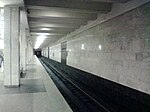Malyshev Factory

The Malyshev Factory (Ukrainian: Завод імені В.О. Малишева, romanized: Zavod imeni V.O. Malysheva; abbreviated ЗІМ, ZIM), formerly the Kharkov Locomotive Factory (Харьковский паровозостроительный завод, Khar'kovskiy parovozostroitel'nyy zavodХПЗ, KhPZ), is a state-owned manufacturer of heavy equipment in Kharkiv, Ukraine. It was named after the Soviet politician Vyacheslav Malyshev. The factory is part of the State Concern UkrOboronProm (Ukrainian Defense Industry). It produces diesel engines, farm machinery, coal mining, sugar refining, and wind farm equipment, but is best known for its production of Soviet tanks, including the BT tank series of fast tanks, the famous T-34 of the Second World War, the Cold War T-64 and T-80, and their modern Ukrainian successor, the T-84. The factory is closely associated with the Morozov Design Bureau (KMDB), designer of military armoured fighting vehicles and the Kharkov Engine Design Bureau (KEDB) for engines. During 1958 it constructed "Kharkovchanka", an off-road vehicle which reached the South Pole the following year. At its height during the Soviet era, the factory employed 60,000 of Kharkiv's 1.5 million inhabitants.As of 2015, 5,000 people worked at the factory.
Excerpt from the Wikipedia article Malyshev Factory (License: CC BY-SA 3.0, Authors, Images).Malyshev Factory
Plekhanivska Street, Kharkiv Балашовка
Geographical coordinates (GPS) Address Nearby Places Show on map
Geographical coordinates (GPS)
| Latitude | Longitude |
|---|---|
| N 49.969722222222 ° | E 36.280833333333 ° |
Address
Plekhanivska Street 126а/7
61037 Kharkiv, Балашовка
Kharkiv Oblast, Ukraine
Open on Google Maps








